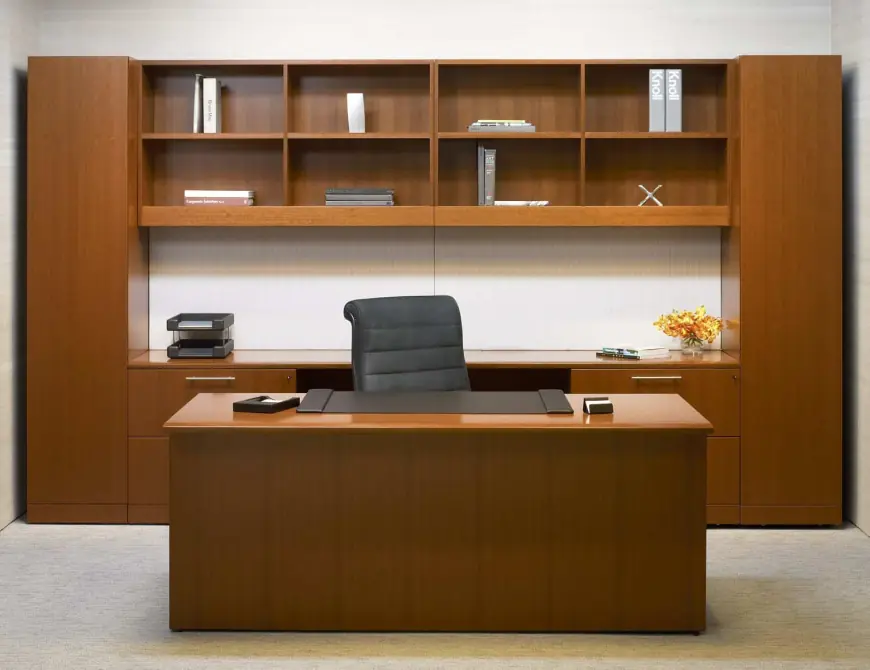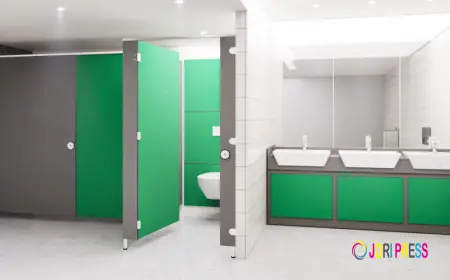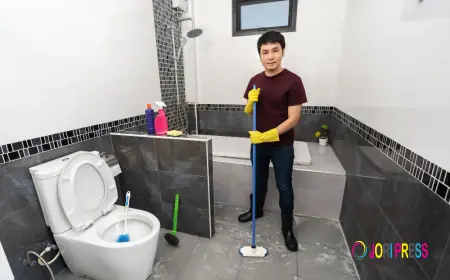2025 Private Office Furniture Trends: What’s In and What’s Out
This guide covers what’s trending in private office furniture this year — what’s in, what’s out, and what you need to create a stylish, functional private office.

As work culture evolves and office environments adapt to new demands, so too does the world of private office furniture. Gone are the days of one-size-fits-all executive desks and oversized filing cabinets. In 2025, office furniture is all about smart functionality, wellness-driven design, minimalism, and eco-conscious choices.
For professionals looking to refresh their private workspaces, keeping up with the latest trends ensures your office stays modern, comfortable, and reflective of current tastes.
Why Staying on Top of Furniture Trends Matters
The design and layout of your private office directly affect your productivity, comfort, and professional image. Outdated, bulky, or impractical furniture can hinder workflow and make your space feel uninviting. Updated private office furniture not only improves functionality but also leaves a positive impression on clients and visitors, subtly communicating that you value efficiency, innovation, and personal wellness.
Modern furniture trends reflect broader workplace priorities: ergonomics, flexibility, sustainability, and clean, distraction-free environments. By choosing current, well-designed pieces, you elevate your workday experience and create a space where productivity thrives.
What’s In: 2025 Private Office Furniture Trends
Ergonomic, Wellness-Focused Furniture
Health-conscious furniture continues to lead design trends, with ergonomic chairs, sit-stand desks, and supportive monitor arms dominating the market. Professionals now expect private office furniture that promotes movement and reduces strain during long workdays.
Adjustable desks with programmable height settings allow easy transitions between sitting and standing. Chairs featuring dynamic lumbar support, breathable mesh, and customizable tilt functions help prevent discomfort and injury. Monitor risers and footrests are increasingly integrated into modern setups for all-day ergonomic comfort.
Minimalist, Clutter-Free Layouts
Gone are overly decorated, crowded offices. In 2025, clean, minimalistic private office furniture designs with simple lines, open surfaces, and neutral color palettes take center stage. Furniture is designed to serve a clear purpose while contributing to a calm, organized environment.
L-shaped desks with built-in storage, modular shelves, and under-desk filing units help reduce clutter without sacrificing functionality. Matte finishes in soft neutrals like beige, warm greys, and light wood tones complement this minimalist aesthetic.
Eco-Friendly and Sustainable Materials
Environmental responsibility is no longer a niche concern. Sustainable private office furniture made from bamboo, reclaimed wood, recycled metal, and low-VOC finishes is a leading priority for modern professionals.
Furniture brands increasingly prioritize ethical production practices, ensuring that private offices can be stylish, functional, and environmentally responsible. Green certifications and eco-friendly material labels have become key selling points for desks, chairs, and storage solutions.
Smart, Tech-Integrated Desks
Technology continues to merge with workspace furniture. 2025 sees a rise in tech-enhanced private office furniture, particularly desks equipped with built-in wireless charging pads, USB-C hubs, Bluetooth speakers, and cable management systems.
Adjustable standing desks now feature digital touchscreens with customizable memory settings, timers to encourage posture changes, and integrated LED lighting. These innovations allow professionals to seamlessly connect devices and reduce desk clutter.
Modular, Reconfigurable Furniture Systems
Flexibility is vital in modern offices, making modular private office furniture a top choice. Modular desks, shelving, and seating allow you to reconfigure your layout as needs change, supporting evolving workflows, meetings, or personal preferences.
Multi-functional storage units, stackable shelves, and movable seating help make the most of limited floor space while maintaining a cohesive, polished look. Professionals can easily adapt their office without purchasing new furniture.
Warm, Natural Color Palettes
While cool greys and stark whites dominated office design in previous years, 2025 welcomes warmer, earthy tones. Light oak, walnut, sand, terracotta, and sage green are replacing high-gloss black or chrome finishes. These organic hues foster a more relaxed, welcoming atmosphere in private offices.
Subtle, Layered Textures
Texture is making a quiet but noticeable return. Expect to see fabric-wrapped desk panels, soft wool upholstery, matte wood grains, and brushed metal accents in modern private office furniture. These layered materials create depth and visual interest without overwhelming the room.
What’s Out in 2025
Oversized, Bulky Desks
Large, imposing executive desks with heavy paneling and intricate carving are losing favor. Today’s professionals prioritize functionality and clean aesthetics. Sleek, streamlined desks with integrated storage and adjustable features have replaced their bulky predecessors.
All-White, Sterile Offices
While minimalist designs remain popular, sterile all-white offices feel impersonal and cold in 2025. The new trend embraces soft, earthy tones and natural materials to create a workspace that feels comfortable and lived-in.
Fixed, Non-Adjustable Furniture
Furniture without ergonomic adjustability is quickly becoming obsolete. Professionals now expect private office furniture that adapts to individual comfort preferences, whether through adjustable chair arms, tilting backrests, or height-variable desks.
Plastic, Low-Quality Materials
Disposable furniture made from low-grade plastics and particleboard is no longer acceptable in high-functioning private offices. Today’s professionals demand durability, sustainability, and aesthetics from their private office furniture, prioritizing long-lasting materials like bamboo, recycled wood, and solid metal frames.
How to Refresh Your Private Office with 2025 Trends
Adopting modern private office furniture trends doesn’t require a complete overhaul. Start with small, impactful changes:
Replace your desk chair with an ergonomic, adjustable model.
Add a sit-stand desk or monitor riser for better posture.
Swap outdated storage for modular, multi-functional shelving units.
Incorporate eco-friendly, sustainably sourced materials where possible.
Rearrange your layout for a cleaner, minimalistic look with clear pathways.
Layer soft lighting, indoor plants, and textured accessories for a more inviting atmosphere.
Popular Private Office Furniture Materials in 2025
Bamboo: Lightweight, durable, and eco-friendly, bamboo desks and chairs offer a sustainable alternative to traditional hardwoods.
Tempered Glass: For a clean, modern feel, tempered glass surfaces remain a popular choice, especially for desktops and minimalist shelving.
Walnut and Oak Veneers: Rich, warm wood tones create a sense of calm and executive sophistication.
Recycled Metal: Strong, industrial-inspired metal frames are both durable and environmentally responsible.
Breathable Mesh: Chairs made with mesh backs and seats improve airflow and comfort during long workdays.
Frequently Asked Questions (FAQs)
Q1: What’s the biggest private office furniture trend in 2025?
A: Wellness-driven, ergonomic private office furniture remains the leading trend, with adjustable desks, supportive chairs, and modular storage systems designed to enhance comfort, productivity, and flexibility.
Q2: Is minimalist furniture still popular in modern private offices?
A: Yes, but with warmer color palettes and subtle textures replacing sterile all-white looks. Minimalist private office furniture now focuses on functionality, clean lines, and clutter-free layouts enhanced with natural materials.
Q3: How can I make my office more eco-friendly without replacing everything?
A: Start by adding eco-friendly accent pieces like bamboo shelves, recycled metal chairs, or sustainably made storage units. You can also introduce energy-efficient lighting and repurpose existing furniture where possible.
Q4: Are smart desks worth the investment?
A: Absolutely. Smart desks improve comfort, connectivity, and workflow with features like digital height adjustments, built-in chargers, and cable management systems. They offer long-term health and productivity benefits in any private office furniture setup.
Q5: What furniture materials are best for durability in a private office?
A: Solid wood, tempered glass, recycled metal, and high-quality mesh or leather upholstery offer durability, aesthetics, and longevity for private office furniture pieces used daily.
Conclusion
As 2025 unfolds, private office furniture is evolving to meet the demands of modern professionals seeking comfort, flexibility, and sustainability in their work environments. From ergonomic chairs and adjustable desks to modular storage and eco-friendly materials, today’s furniture trends prioritize wellness and practical design without sacrificing style.
Whether you’re updating a small home office or redesigning a spacious executive suite, embracing these trends will help create a workspace that enhances your daily performance while reflecting current design values. Thoughtfully chosen, modern private office furniture turns any office into a dynamic, efficient, and visually impressive professional space.
What's Your Reaction?
 Like
0
Like
0
 Dislike
0
Dislike
0
 Love
0
Love
0
 Funny
0
Funny
0
 Angry
0
Angry
0
 Sad
0
Sad
0
 Wow
0
Wow
0

















































